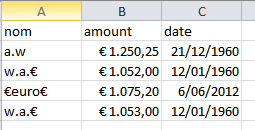- Home
- /
- Analytics
- /
- SAS Data Science
- /
- Re: Reading Euro symbol from external file
- RSS Feed
- Mark Topic as New
- Mark Topic as Read
- Float this Topic for Current User
- Bookmark
- Subscribe
- Mute
- Printer Friendly Page
- Mark as New
- Bookmark
- Subscribe
- Mute
- RSS Feed
- Permalink
- Report Inappropriate Content
Hi,
I'm getting problem reading Euro symbol € from exeternal file.
Here you are the code:
data mydatset;
infile "&localfilename" delimiter=',' dsd missover firstobs=2;
informat
Date yymmdd10.
Name $100.
;
format
Date date9.;
input
Date
Index_Name $
;
run;
If in my external file there is an Europ symbol (€), I can't get it in mydataset but a strange square is showed.
Any idea abou thow to fix it?
Many thanks
- Mark as New
- Bookmark
- Subscribe
- Mute
- RSS Feed
- Permalink
- Report Inappropriate Content
The square is probably how your current character set displays that character. To see what actual ASCII code has been read from your file put the string using the $HEX format. This will display each character as two hexadecimal digits representing the 8 bit code. For example the digit zero is 30 in hex. The letter A is 41. The letter J is 4A.
- Mark as New
- Bookmark
- Subscribe
- Mute
- RSS Feed
- Permalink
- Report Inappropriate Content
I have tried from a french excel 2010 saving in csv like this but my sas is also regulated in latin1 with french language.
My try with amounf countaining an euro formatted excel

saved in european csv where delimiter is = ; as comma is the decimal separator gives under ultraedit

euro symbol is represented in hex as 80 issued from excel2010
under ultraedit i saved too the csv file in utf8 encoding for my second try
and in both case in sas this program was correct with the same result for both

code but recall i am under a french version of sas
so you may try with the encoding of euro exists too under iso8859-15 equivalent of latin9
data try1;
infile "d:\temp\euro1.csv" delimiter=';' dsd missover firstobs=2;* encoding='latin9';
informat
Name $10. amount eurox10.2 Date ddmmyy10. ;
format Date date9.;
input
name $ amount Date ;
run;
data try2;
infile "d:\temp\euro1utf8.csv" delimiter=';' dsd missover firstobs=2 encoding='utf8';
informat
Name $10. amount eurox10.2 Date ddmmyy10. ;
format Date date9.;
input
name $ amount Date ;
run;
the other solution is applying a nls informat to a variable that is not well presenting
as some utf8 character was embedded inside so perhaps:
x=input ( name, $utf8x10.);
HTH
Andre
- Mark as New
- Bookmark
- Subscribe
- Mute
- RSS Feed
- Permalink
- Report Inappropriate Content
There is a new book at SAS
"Sas encoding understanding the details " by Manfred Kiefer 175 p
where the euro symbol is well mentionned as Latin9 !
http://support.sas.com/publishing/authors/kiefer.html
options locale=fr_FR; this options seems now from 9.3 accepted by SAS Foundation
so if anybody in the USA can test my answer on an american version of SAS
it may be now more easier to treat those kind of difficulties without the reserve i have presented in matter of encoding=
and after return to
options local=English_UnitedStates;
sorry but after reading more into the nls manual
the change of locale has only effect upon
dflang= datestyle= and papersize=
sorry again you have to start sas with another encoding or make use of the encoding= options in proc import, infile and so on
Andre
Don't miss out on SAS Innovate - Register now for the FREE Livestream!
Can't make it to Vegas? No problem! Watch our general sessions LIVE or on-demand starting April 17th. Hear from SAS execs, best-selling author Adam Grant, Hot Ones host Sean Evans, top tech journalist Kara Swisher, AI expert Cassie Kozyrkov, and the mind-blowing dance crew iLuminate! Plus, get access to over 20 breakout sessions.
Use this tutorial as a handy guide to weigh the pros and cons of these commonly used machine learning algorithms.
Find more tutorials on the SAS Users YouTube channel.


